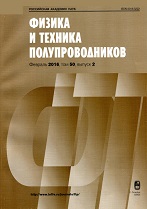|
|
Fizika i Tekhnika Poluprovodnikov, 2020, Volume 54, Issue 4, Page 371
(Mi phts6640)
|
 |
|
 |
This article is cited in 2 scientific papers (total in 2 papers)
Amorphous, glassy, organic semiconductors
Growth and characterization of TCNQ-doped Ni(II)TAAB thin film as a new $\pi$-conjugated organic semiconductor
M. E. Sánchez-Vergaraa, B. Molinab, A. Hernández-Garcíaa, J. R. Álvarez-Badaa, R. Salcedoc
a Universidad Anahuac México. Avenida Universidad Anáhuac 46, Col. Lomas Anáhuac,
Huixquilucan 52786, Estado de México, México
b Facultad de Ciencias, Universidad Nacional Autónoma de
México, Circuito Exterior s/n, ciudad universitaria,
Coyoacán, 04510, Ciudad de México, México
c Instituto de Investigaciones en Materiales, Universidad Nacional
Autónoma de México, circuito exterior s/n,
Ciudad Universitaria, Coyoacán 04510, Ciudad de México, México
Abstract:
The aim of this work was to obtain a $\pi$-conjugated organic semiconductor with the macrocycle Ni(II)(TAAB) ([tetrabenzo $(b,f,j,n)$[1,5,9,13]tetraazacyclohexadecine]Ni(II) and the electronic acceptor TCNQ (tetracyano-$\pi$-quinodimethane), in which hydrogen bonds are formed between TCNQ and Ni(II)(TAAB). Theoretical calculations based on DFT with dispersion force analysis were carried out in order to simulate molecular interaction and to establish the nature of the bonds between both fragments. Thin films of TCNQ-doped Ni(II)TAAB organic semiconductor were obtained through high vacuum evaporation and were structurally and morphological characterized by IR spectroscopy, X-ray diffraction analysis (XRD), and scanning electron microscopy (SEM). The absorption coefficient $(\alpha)$ and photon energy $(h\nu)$ were calculated from UV-Vis spectroscopy and used to determine the Tauc band gap of the film. This quasi-experimental band gap was compared with that obtained by DFT; both results are in the range established for organic semiconductors. The electrical properties of the organic semiconductor have been obtained from a simple anode|TCNQ-doped Ni(II)TAAB|cathode device. The conductivity of this device was determined from electrical measurements of $I(V)$. TCNQ-doped Ni(II)TAAB has semiconducting characteristics and its conductivity values are of order 10$^{-5}$ S $\cdot$ cm$^{-1}$. Band gap determination and the $I(V)$ study were both carried out in order to analyze the effect of doped TCNQ in the macrocycle. This work suggests that TCNQ-doped Ni(II)TAAB represents an alternative approach to obtaining a semiconductor-like behaviour that may be suitable for organic electronic applications.
Keywords:
organic semiconductor, thin films, theoretical calculations, band gap, electrical properties.
Received: 07.07.2019
Revised: 01.12.2019
Accepted: 01.12.2019
Citation:
M. E. Sánchez-Vergara, B. Molina, A. Hernández-García, J. R. Álvarez-Bada, R. Salcedo, “Growth and characterization of TCNQ-doped Ni(II)TAAB thin film as a new $\pi$-conjugated organic semiconductor”, Fizika i Tekhnika Poluprovodnikov, 54:4 (2020), 371; Semiconductors, 54:4 (2020), 441–449
Linking options:
https://www.mathnet.ru/eng/phts6640 https://www.mathnet.ru/eng/phts/v54/i4/p371
|


| Statistics & downloads: |
| Abstract page: | 49 | | Full-text PDF : | 13 |
|



 Contact us:
Contact us: Terms of Use
Terms of Use
 Registration to the website
Registration to the website Logotypes
Logotypes